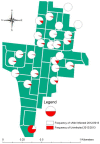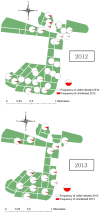Stability of the wMel Wolbachia Infection following invasion into Aedes aegypti populations
- PMID: 25211492
- PMCID: PMC4161343
- DOI: 10.1371/journal.pntd.0003115
Stability of the wMel Wolbachia Infection following invasion into Aedes aegypti populations
Abstract
The wMel infection of Drosophila melanogaster was successfully transferred into Aedes aegypti mosquitoes where it has the potential to suppress dengue and other arboviruses. The infection was subsequently spread into two natural populations at Yorkeys Knob and Gordonvale near Cairns, Queensland in 2011. Here we report on the stability of the infection following introduction and we characterize factors influencing the ongoing dynamics of the infection in these two populations. While the Wolbachia infection always remained high and near fixation in both locations, there was a persistent low frequency of uninfected mosquitoes. These uninfected mosquitoes showed weak spatial structure at both release sites although there was some clustering around two areas in Gordonvale. Infected females from both locations showed perfect maternal transmission consistent with patterns previously established pre-release in laboratory tests. After >2 years under field conditions, the infection continued to show complete cytoplasmic incompatibility across multiple gonotrophic cycles but persistent deleterious fitness effects, suggesting that host effects were stable over time. These results point to the stability of Wolbachia infections and their impact on hosts following local invasion, and also highlight the continued persistence of uninfected individuals at a low frequency most likely due to immigration.
Conflict of interest statement
The authors have declared that no competing interests exist.
Figures





References
-
- Carrington LB, Leslie J, Weeks AR, Hoffmann AA (2009) The popcorn Wolbachia infection of Drosophila melanogaster. Can selection alter Wolbachia longevity effects? Evolution 63: 2648–2657. - PubMed
-
- Jaenike J, Dyer KA (2008) No resistance to male-killing Wolbachia after thousands of years of infection. Journal of Evolutionary Biology 21: 1570–1577. - PubMed
-
- Hoffmann AA, Turelli M, Simmons GM (1986) Unidirectional incompatibility between populations of Drosophila simulans . Evolution 40: 692–701. - PubMed
Publication types
MeSH terms
LinkOut - more resources
Full Text Sources
Other Literature Sources

